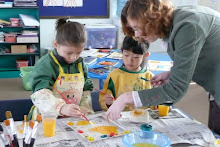"Information technology is identity technology. Embedding it in a culture that supports democracy, freedom of expression, tolerance, diversity, and complexity of opinion is one of the decade's greatest challenges."
• What role could multimedia instructional materials and student multimedia projects play in bringing about this culture?
This quote struck me as somewhat ironic, considering that the country I live in realizes the validity of how information technology transforms identity and supports freedom of speech, etc. To that end, many information and social networking technologies end up blocked by the government. Even this blog that I write in is inaccessible without a VPN. As part of a culture that is trying to censor their population, in the classroom efforts by Western teachers often suffer. A use of a wiki to share who our class is and what our class is learning just isn’t always feasible due to internet blocking and other issues beyond our control.
• How can teachers' use of multimedia support the development of such a culture?
In an international school setting, students are constantly searching for their place and where they belong and who they are. Technology allows for students to connect with other TCK students around the world.
In my experience, when students feel as if who they are is valued both inside and outside the classroom, they perform better and have higher motivation to learn. Multimedia in the classroom helps these students be able to express themselves in a way that they might not otherwise be able to do – both academically and socially. I think this is especially important when you live in a culture that is trying to reverse this trend.
• What are the challenges in your classroom?
In my classroom, the language barrier is of course huge. In some aspects, we are asking these children to put aside for large amounts of time per day who they are. Language is one of the biggest ways that they identify themselves and we tell them they must put that aside and communicate in English. Once a basic level of proficiency is obtained, this too is used to identify themselves (I speak English and he doesn’t), express themselves through opinions (I want to do this instead of that), measure diversity (Bob can speak three languages and Sally can speak four). Technology is very helpful in scaffolding my student’s language development but it also presents challenges as the technology is not equally distributed to all students.
Tuesday, March 30, 2010
Subscribe to:
Post Comments (Atom)


No comments:
Post a Comment